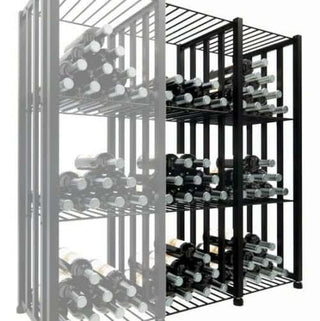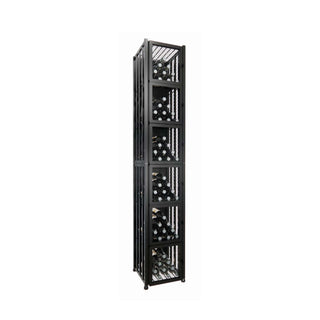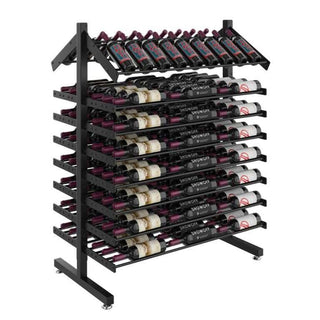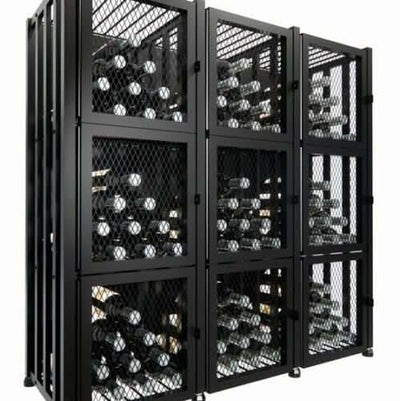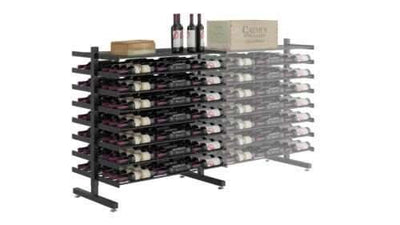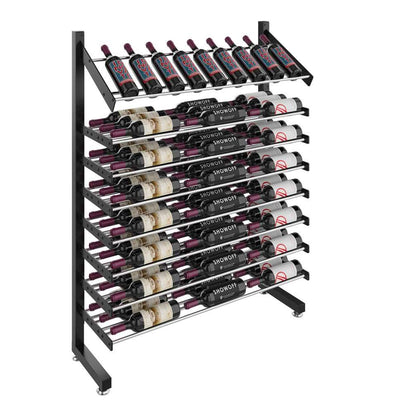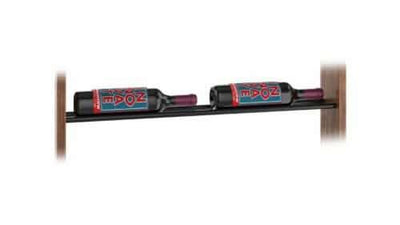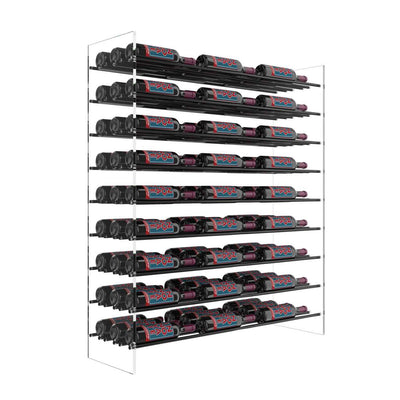Wine rack dimensions are more than mere numbers. They are the keys to creating an efficient and visually pleasing wine storage solution.
In this article, we embark on a voyage into the world of wine storage, with a particular focus on the pivotal role that wine racks play in safeguarding your liquid treasures. Our mission is to provide you with a comprehensive understanding of basic wine rack dimensions, ensuring you make the right choices for your wine storage needs.
Wine Rack Variety
Wine racks offer diverse styles and designs, each tailored to suit specific preferences, requirements, and spatial constraints. The following categories encompass the various types of available wine racks: wall-mounted, countertop, and floor-standing.
The choice of wine rack, type is of paramount importance, as it directly impacts the dimensions and functionality of your wine storage solution. This section will delve into these types in detail, shedding light on their distinct characteristics and purposes.
- Wall-Mounted Wine Racks
Wall-mounted wine racks are an excellent choice for those seeking to maximize space efficiency and aesthetics.
These racks are designed to be affixed to your wall, creating a visually appealing display for your wine collection. They come in various materials, including wood, metal, and acrylic, allowing you to choose one that complements your decor.
Wall-mounted wine racks are perfect for smaller spaces or creating a decorative focal point in a room. They can hold a varying number of bottles, typically ranging from a few to several dozen, depending on the design.
- Countertop Wine Racks
Countertop or tabletop wine racks are versatile and ideal for wine enthusiasts who want easy access to their bottles without needing wall installation. These racks are typically compact and can be placed on kitchen countertops, bars, or any flat surface.
They come in various sizes and styles, making them suitable for small and large collections. Countertop wine racks often accommodate fewer bottles than floor-standing alternatives but offer the advantage of convenience and flexibility in placement.
- Floor-Standing Wine Racks
Floor-standing wine racks are the go-to choice for serious wine collectors or those with extensive wine collections. These racks are usualy larger in size and capable of holding a significant number of bottles, ranging from several dozen to hundreds, depending on the design.
They are impressive display pieces and can be placed in wine cellars, dining rooms, or living spaces. Floor-standing wine racks are available in various materials, from classic wooden designs to modern metal and glass constructions, allowing you to find one that matches your style and storage needs.
Standard Wine Bottle Dimensions
Wine bottles are available in various shapes and sizes, with Bordeaux and Burgundy styles as two of the most prevalent. In this section, we will explore the standard dimensions of these bottles and explain why grasping these measurements is pivotal for the design and arrangement of your wine rack.
- Bordeaux Wine Bottles
Bordeaux-style wine bottles are recognized by their classic, straight-sided shape. They are typically used for wines like Cabernet Sauvignon, Merlot, and Bordeaux blends.
The standard dimensions of a Bordeaux wine bottle are approximately 12 inches (30.5 cm) in height and 2.75 inches (7 cm) in diameter.
Understanding these dimensions is crucial as they serve as a benchmark for designing wine rack slots or compartments. Ensuring that your wine rack can accommodate Bordeaux bottles ensures versatility for a wide range of red wines.
- Burgundy Wine Bottles
Burgundy-style wine bottles feature a wider, more rounded body than Bordeaux bottles. They are often used for wines like Pinot Noir and Chardonnay.
The standard dimensions of a Burgundy wine bottle are approximately 11.5 inches (29 cm) in height and 3 inches (7.6 cm) in diameter. Burgundy bottles require slightly larger slots or compartments to fit comfortably.
These dimensions may serve as your initial reference points, but it’s essential to note that wine bottles come in various shapes and sizes beyond Bordeaux and Burgundy styles. Other wine regions and varietals may have unique bottle shapes, which should also be considered when designing your wine rack.
Factors Influencing Wine Rack Dimensions
Now, let’s unravel the essential factors that act as the architects of wine rack dimensions. These pivotal considerations encompass storage capacity, available space, and bottle orientation (horizontal or vertical).
These factors intermingle and influence one another, making it vital to grasp their dynamics to craft a practical and efficient wine storage solution.
- Storage Capacity
The primary factor in determining wine rack dimensions is the quantity of bottles you intend to store. Consider whether you are an occasional wine enthusiast with a modest collection or a passionate collector with an extensive array of wines.
To estimate storage capacity accurately, factor in the standard dimensions of wine bottles, as discussed in the previous section. Remember to account for different bottle sizes and shapes beyond Bordeaux and Burgundy.
- Available Space
The physical space you have allocated for your wine rack will profoundly impact its dimensions. Measure the designated area carefully, taking into account any height or width restrictions.
Ensure that there is adequate space around the wine rack for easy access and maintenance. Additionally, consider the aesthetics and how the rack fits your interior design scheme.
- Bottle Orientation
Decide whether you prefer horizontal or vertical storage for your wine bottles. Horizontal storage, with bottles lying on their sides, is ideal for long-term aging as it keeps corks moist. Vertical storage is more space-efficient but may not be suitable for wines intended for aging.
Horizontal storage will necessitate deeper wine rack compartments to accommodate the bottle length, while vertical storage requires taller compartments to hold the bottles upright.
By understanding these factors and how they relate to your needs and space constraints, you can tailor your wine rack dimensions to create a harmonious and functional storage solution for your wine collection.
Ideal Wine Rack Dimensions
In this section, we will guide you on the ideal wine rack dimensions to help you create a wine storage solution that meets your specific needs and preferences. These recommendations will cover depth, width, and height, offering examples of common wine rack sizes that cater to various scenarios.
- Depth
The depth of your wine rack should be carefully considered to ensure it accommodates your wine bottles effectively.
Standard wine bottle dimensions, as discussed earlier, play a pivotal role here. Typically, a wine rack depth of at least 11 inches (28 cm) is recommended to comfortably accommodate Bordeaux-style bottles.
For versatility and to accommodate a variety of bottle shapes and sizes, a depth of 12 to 14 inches (30.5 to 35.6 cm) is a safe choice.
- Width
The width of your wine rack should align with the available space and the number of bottles you plan to store.
A standard wine rack width for residential use often ranges from 24 to 36 inches (61 to 91 cm). This allows for accommodating anywhere from a few dozen to several hundred bottles, depending on the design and bottle orientation.
Consider narrower wine racks for smaller collections, while larger collections may require wider configurations.
- Height
The height of your wine rack is influenced by bottle orientation and the available vertical space.
For horizontal storage, wine racks typically have compartments with a height of around 8 to 10 inches (20 to 25.4 cm) to accommodate Bordeaux-style bottles lying on their sides.
If you prefer vertical storage, consider racks with compartments that are 12 to 14 inches (30.5 to 35.6 cm) tall to accommodate bottles standing upright.
Remember that these are general recommendations. The ideal wine rack dimensions ultimately depend on your unique circumstances. Customization is key, so be sure to adapt these dimensions to match the specific needs of your wine collection and the available space in your home.
By following these guidelines and tailoring the dimensions to your preferences, you can create a wine rack that stores your bottles securely and enhances the aesthetics of your wine storage area.
Custom vs. Pre-Made Wine Racks
In this section, we will compare custom-built and pre-made wine racks, with a particular emphasis on how custom wine racks provide unparalleled flexibility in terms of dimensions, allowing you to tailor your wine storage solution to precise specifications and space requirements.
- Pre-Made Wine Racks
Convenience: Pre-made wine racks are available in various sizes and styles, so they’re a convenient choice for those who want a quick and easy solution.
Cost-Efficiency: They are often more budget-friendly than custom-built racks since they are produced in bulk.
Limited Dimensions: However, pre-made racks may have limited options when it comes to dimensions. You might need to compromise on size and bottle capacity to fit your available space.
- Custom-Built Wine Racks
Tailored to Your Needs: Custom wine racks offer the advantage of being tailored to your needs. You can specify the exact dimensions, materials, and design elements to match your space and collection requirements.
Optimal Use of Space: With custom racks, you can maximize available space, ensuring that every inch is utilized efficiently.
Aesthetic Harmony: Custom-built wine racks allow seamless integration into your home’s interior design, ensuring that the rack complements your décor perfectly.
Investment: Custom-built wine racks offer unparalleled flexibility but often come at a higher cost due to the craftsmanship and customization involved.
When deciding between custom and pre-made wine racks, consider the following:
Space Availability: If you have limited space or a specific area designated for your wine storage, a custom rack can be tailored to fit seamlessly.
Collection Size: If you have an extensive wine collection, a custom wine rack can be designed to accommodate your bottles comfortably.
Design Aesthetic: If you desire a wine rack that harmonizes with your home’s overall design and aesthetics, custom-built options provide the flexibility needed.
Ultimately, the choice between custom and pre-made wine racks hinges on your preferences, budget, and the specific requirements of your wine storage area. Custom wine racks offer the advantage of tailored dimensions, ensuring that your wine storage solution perfectly aligns with your collection and space. Thus, they’re perfect for a personalized and efficient storage solution.
How Each Material Affects Wine Rack Dimensions
- Wooden Wine Racks
Aesthetics: Wooden wine racks are known for their classic and elegant appearance. They often have thicker components, such as posts and shelves, which can contribute to their overall bulkier dimensions.
This can be especially noticeable in the depth and width of the rack. The choice of wood type and rack design can also influence its size. For example, a solid hardwood wine rack may have thicker components than a engineered wood or veneer rack.
Dimensional Flexibility: Wood offers a high degree of dimensional flexibility. Custom wood wine racks can be designed to precisely fit your available space and bottle collection.
You can adjust depth, width, and height of individual compartments to match your needs. However, remember that the natural thickness of wood components may limit the overall slimness of the rack.
- Metal Wine Racks
Sleek Aesthetics: Metal wine racks are often chosen for their sleek and modern appearance. They typically have thinner materials, which contribute to a more compact profile. This slimness can be advantageous in terms of space efficiency, especially in tight spaces.
Space-Efficiency: Metal wine racks are inherently space-efficient due to their thinner construction. However, they may have fixed dimensions, particularly in height and width.
Customization options with metal racks may be limited compared to wood. Therefore, it’s essential to select a metal rack that closely matches your space or be prepared for potential limitations in bottle capacity.
- Acrylic Wine Racks
Transparency and Elegance: Acrylic wine racks are appreciated for their transparent and elegant appearance. They often have thinner components, contributing to their sleek profile. The transparency of acrylic can create an illusion of space, making the rack appear less imposing.
Dimensional Versatility: Acrylic is highly customizable and can be molded and shaped to fit precise dimensions. This makes it an excellent choice for those seeking a wine rack that maximizes space utilization while maintaining an elegant appearance. However, since acrylic is less robust than wood or metal, proper support is essential to prevent sagging or breakage.
The choice of material significantly impacts wine rack dimensions. Wood wine racks tend to be bulkier due to thicker components, while metal racks are often slimmer but may have fixed dimensions. Acrylic racks offer versatility in dimensions and a sleek, transparent appearance.
When selecting a material, consider the aesthetic appeal, available space, and customization options to ensure your wine rack stores your bottles effectively and complements your overall design scheme.
Frequently Asked Questions about Wine Rack Dimensions
- How does the size of wine bottles affect the dimensions of a wine rack?
Wine bottle size impacts a wine rack’s depth, width, and height. Larger bottles require deeper and wider compartments, while taller bottles necessitate taller rack sections. Rack dimensions should accommodate various bottle sizes and shapes to ensure versatility.
- What is the ideal wine rack depth for horizontal storage?
The ideal depth for a wine rack designed for horizontal storage is typically between 12 to 14 inches (30.5 to 35.6 cm). This accommodates the length of standard wine bottles lying on their sides.
- How do I determine the width of my wine rack?
The width of your wine rack should be chosen based on the available space and the number of bottles you intend to store. Common widths for residential wine racks range from 61 to 91 cm (24″ to 36″).
- What should I consider when determining the height of my wine rack compartments?
The height of wine rack compartments depends on whether you prefer horizontal or vertical storage. Compartments are typically 8 to 10 inches (20 to 25.4 cm) tall for horizontal storage. For vertical storage, compartments should be 12 to 14 inches (30.5 to 35.6 cm) to accommodate bottles standing upright.
- Can I mix bottle sizes and shapes in the same wine rack?
Yes. You can mix different bottle sizes and shapes in the same wine rack. To ensure versatility, design your wine rack with adjustable compartments or various-sized slots to accommodate different bottles effectively.
- Are there standard dimensions for countertop wine racks?
Countertop wine racks vary in size, but they are typically designed to fit on standard kitchen countertops. Common dimensions for countertop wine racks include a width of 18 to 24 inches (45.7 to 61 cm) and a depth of 8 to 12 inches (20.3 to 30.5 cm).
- Are there specific dimensions for wine racks designed for wine cellars?
Wine cellars often have custom-built wine racks that can vary widely in size and design. The dimensions of a wine cellar rack should be tailored to the available space and the collector’s preferences, taking into account both horizontal and vertical storage needs.
Conclusion
Understanding the basic wine rack dimensions is essential for creating an efficient and visually appealing wine storage solution. Standard wine bottle dimensions, including those for Bordeaux and Burgundy bottles, provide the foundation for designing rack compartments.
Ultimately, the dimensions of your wine rack should align with your collection’s needs and the available space, ensuring that it not only stores your bottles securely but also enhances the aesthetics of your wine storage area.

























